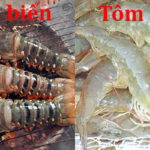The moonfish, or mola mola, is a rare and unique fish species found in Vietnam. To learn more about this fascinating fish, join us as we explore its characteristics, habitat, and more in the article below.
1. What is a Moonfish?
 What is a Moonfish?
What is a Moonfish?
Origin of Moonfish
Scientifically known as Mola mola, moonfish belong to the order Tetraodontiformes, which includes pufferfish and sunfish. They are typically found in deep, cold waters.
In languages such as Russian, Spanish, Portuguese, French, Italian, and Dutch, this fish is called moonfish, likely due to its round shape resembling a full moon. However, in English, it is commonly referred to as an ocean sunfish because of its tendency to swim close to the surface, appearing to sunbathe.
Characteristics of Moonfish
Moonfish are known for their enormous size, with a short, oval-shaped body that is laterally compressed. Their skin is thin but has a rough texture. The upper part of their body is usually gray or brown, while the underside is lighter.
The rear of the moonfish features two short, symmetrical dorsal and anal fins. Their most distinctive features include a small mouth and gill slits. Despite their massive size, moonfish move slowly due to their short body shape, which limits their swimming ability. As a result, they often relax and allow their bodies to drift with the current, tilting to one side.
Habitat of Moonfish
Moonfish are saltwater fish and are found in tropical oceans worldwide. They can survive at depths of around 200 meters and have been known to dive as deep as 600 meters below the ocean’s surface.
Due to their gentle nature and short, round body shape, moonfish rarely attack other creatures in the deep sea. In Vietnamese waters, moonfish are extremely rare and are therefore on the red list of protected species, with fishing and hunting prohibited to ensure their survival.
2. Can Moonfish Be Eaten?
 Can Moonfish Be Eaten?
Can Moonfish Be Eaten?
Some people may be hesitant to consume moonfish due to their unusual and unappetizing appearance, and they may believe that the fish could be poisonous. However, it is important to know that moonfish are not toxic and are safe to eat. Nevertheless, hunting and consuming moonfish are prohibited in several countries, including Vietnam, due to their rarity and protected status.
3. Moonfish Price and Availability
 Moonfish Price and Availability
Moonfish Price and Availability
Moonfish are considered extremely rare in Vietnamese waters, and they are on the red list of protected species.
As a result, any attempts to catch or trade these fish should be prevented to ensure their conservation. Therefore, information about their market price or availability in Vietnam is not accessible.
We hope you found this article informative and interesting. If you enjoyed reading about the fascinating moonfish, please share it with your friends and family!
What is a Lizard? How to Distinguish the Difference Between a Lizard and an Eel.
Introducing the often-misunderstood and mysterious creature, the “lịch” – a fascinating enigma of the natural world, often confused with its slippery cousin, the eel. With their similar appearances and elusive nature, it’s time to unravel the secrets of the “lịch” and discover what sets it apart from its aquatic doppelganger. Prepare to embark on an enlightening journey as we explore the unique characteristics and intriguing habits of this captivating creature in our upcoming article. Stay tuned, as we unravel the enigma of the “lịch”!
The Nutritional Difference Between Sea and River Shrimp
“Shrimp is a superfood packed with essential nutrients. But which is better, sea or river shrimp? This is a common dilemma for consumers who want to reap the nutritional benefits of this crustacean. Let’s delve into the nutritional differences between these two shrimp varieties and discover which one comes out on top in the culinary world.”

































